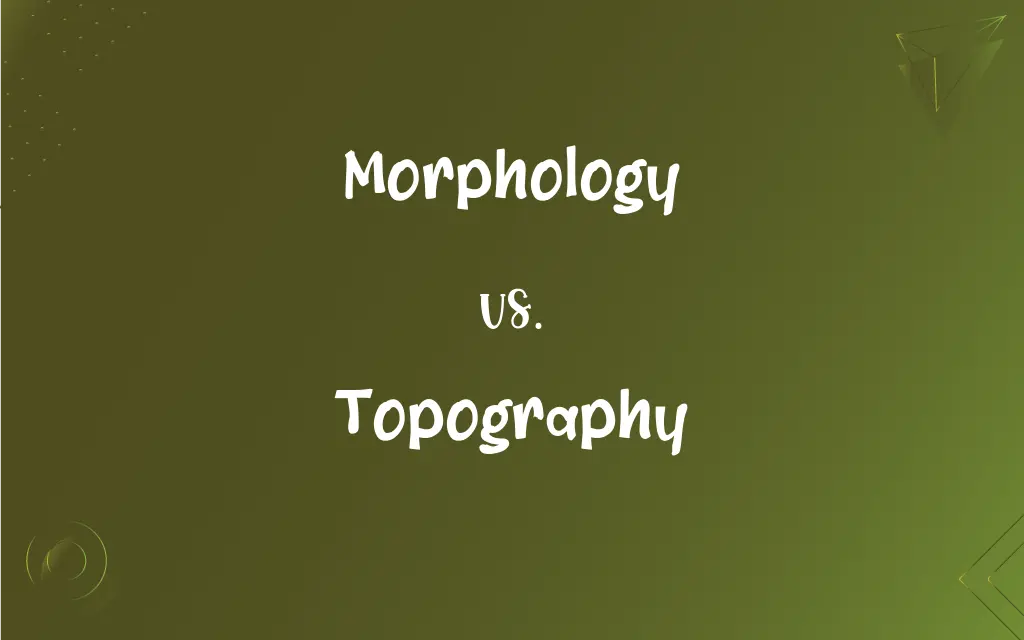Morphology vs. Topography: What's the Difference?
Edited by Aimie Carlson || By Janet White || Published on February 26, 2024
Morphology is the study of the form and structure of organisms or geological formations. Topography is the detailed mapping or charting of the features of a relatively small area, district, or locality.

Key Differences
Morphology is concerned with the structure and form of living organisms, analyzing aspects like shape, size, and anatomical features. Topography, in contrast, focuses on the detailed physical features of a geographical area, including its relief, vegetative cover, and man-made structures.
In biology, morphology examines the external and internal structures of plants and animals, providing insights into their evolutionary adaptations. Topography, in the realm of geography, is used to understand and represent the physical layout of the land, including hills, valleys, rivers, and urban areas.
Geological morphology studies the shapes and features of the Earth's surface, including mountains, valleys, and sediment deposits. Topography, however, maps these features, providing a detailed representation of elevation, slope, and terrain layout.
Morphology is also important in linguistics, where it studies the structure and formation of words. In comparison, topography has no direct application in linguistics but is crucial in environmental planning, where it helps in understanding land use and suitability.
In medical science, morphology refers to the study of the form and structure of organs or tissues, often used in pathology. Topography in this context is related to the mapping of specific body areas for medical procedures like surgery or radiation therapy.
ADVERTISEMENT
Comparison Chart
Focus
Structure and form of organisms
Physical features of geographical areas
Application in Biology
Analyzing organism structures
N/A
Geological Aspect
Study of Earth's surface structures
Mapping Earth's surface features
Linguistic Relevance
Structure and formation of words
N/A
Medical Science
Study of form and structure of tissues
Mapping of body areas for medical purposes
ADVERTISEMENT
Morphology and Topography Definitions
Morphology
The study of the form and structure of organisms.
The morphology of birds' wings is adapted for different types of flight.
Topography
The arrangement of the natural and artificial physical features of an area.
Urban topography involves mapping buildings, roads, and natural features.
Morphology
The branch of biology dealing with the form and structure of living things.
Plant morphology examines the structure and form of various plant species.
Topography
The detailed surface features of an area, including its relief.
The topography of the mountain range includes peaks, valleys, and plateaus.
Morphology
The form and structure of a particular word or word element.
The morphology of the word 'unbelievable' includes the prefix 'un-' and the suffix '-able'.
Topography
The configuration of a surface including its relief and the position of its natural and man-made features.
The topography of the coastal region is important for flood defense planning.
Morphology
In linguistics, the study of the forms of words.
Morphological analysis helps in understanding the relationship between words and their meanings.
Topography
The detailed mapping or description of the features of a small area.
The topography of the valley showed varying elevations and landforms.
Morphology
The branch of geology that deals with the structure of the earth's surface.
The study of river morphology helps in understanding river behavior.
Topography
The field of study concerned with surface relief, vegetation, and man-made structures.
Topography plays a crucial role in environmental and urban planning.
Morphology
The branch of biology that deals with the form and structure of organisms without consideration of function.
Topography
Detailed, precise description of a place or region.
Morphology
The form and structure of an organism or one of its parts
The morphology of a cell.
The morphology of vertebrates.
Topography
Graphic representation of the surface features of a place or region on a map, indicating their relative positions and elevations.
FAQs
What is topography?
The detailed mapping of the features of a small area or locality.
Can morphology refer to languages?
Yes, it studies the structure and formation of words in linguistics.
Can morphology help in identifying species?
Yes, it's key in differentiating species based on structural features.
What is morphology?
The study of the form and structure of organisms or geological formations.
How is morphology used in biology?
It analyzes the structure of plants and animals for evolutionary insights.
How does topography affect environmental planning?
It helps understand land suitability and environmental impacts.
Can topography influence climate?
Yes, landforms can affect local weather and climate patterns.
What does topography include?
It includes terrain features like hills, valleys, rivers, and built structures.
Is topography important in urban planning?
Yes, it’s crucial for understanding land use and physical layout.
Does morphology study human anatomy?
Yes, especially in medical and anthropological contexts.
Does morphology have medical applications?
Yes, it's used in studying the structure of organs and tissues.
Are topographic maps used in navigation?
Yes, they're essential for outdoor navigation and planning.
What role does topography play in agriculture?
It determines land suitability and water management strategies.
Can topography impact real estate development?
Yes, it influences construction feasibility and property values.
How does topography affect biodiversity?
Different landforms can support diverse ecosystems and species.
How is topography measured?
Using methods like surveying, satellite imagery, and GPS.
Is morphology important in taxonomy?
Yes, it helps in classifying organisms based on physical traits.
What tools are used in morphology?
Microscopes, imaging technology, and comparative analysis.
How does morphology relate to evolution?
It provides insights into evolutionary adaptations and changes.
Do linguists use morphology?
Yes, for understanding word formation and syntax in languages.
About Author
Written by
Janet WhiteJanet White has been an esteemed writer and blogger for Difference Wiki. Holding a Master's degree in Science and Medical Journalism from the prestigious Boston University, she has consistently demonstrated her expertise and passion for her field. When she's not immersed in her work, Janet relishes her time exercising, delving into a good book, and cherishing moments with friends and family.
Edited by
Aimie CarlsonAimie Carlson, holding a master's degree in English literature, is a fervent English language enthusiast. She lends her writing talents to Difference Wiki, a prominent website that specializes in comparisons, offering readers insightful analyses that both captivate and inform.
































































